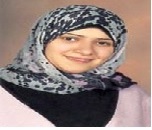
Anfal Ismaeel
Senior Research Associate in KISR
Title: Depositional Fluxes of Radionuclides in Kuwaiti Dust Fallout
Biography
Biography: Anfal Ismaeel
Abstract
Nine stations of the dust collector (PVC bucket of 0.2 m diameter and 0.4 m depth) were deployed to collect dust fallout for the period of 23 mo (Oct 2009 to Aug 2011) on monthly bases. Adequate dust samples were collected using four collectors in each station. The weight of the collected dust were varied from 0.5 g to about 3 g. Ultra Low Background gamma spectrometry equipped with a Broad Energy Germanium detector was used to determine the concentration of (7Be, 210Pb, 40K and 137Cs). However, the corrected factor for the sampling time was applied for the short-lived isotope (7Be). The radionuclide deposition rates were calculated using the massic activities (Bq.g-1) and the deposition fluxes (g m-2 mo-1). The average monthly deposition rates were 35.4, 11.2, 13.2, and 0.3 (Bq m-2 mo-1) for 7Be, 210Pb, 40K and 137Cs, respectively. The temporal variation of the radionuclides depositions rates showed maxima during spring months (February, March, and April) and lowest in October and November. Similar trend was found for the dust deposition rates where the average was 50 mg m-2 h-1 with an extreme value of 664 mg m-2 h-1 was reported during March 2011 when an exotic dust storm hit Kuwait. The correlation between the radionuclide depositional fluxes and the dust deposition rates showed that 40K has the strongest correlation (0.92) while the 7Be was the weakest (0.67). The maximum of the annual effective dose of 137Cs inhalation was found negligible (2.43 10-3 mSv).

